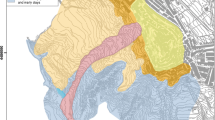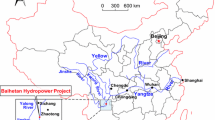Abstract
This study systematically investigates the failure mechanism and dynamic process of a long run-out landslide in Jichang town based on multiple-integrated geotechniques including field investigations, remote sensing analysis, electrical resistivity tomography (ERT) analysis, seismic signal analysis, and numerical simulations. Multi-period remote sensing images show that there was no deformation of the slope before failure that the landslide occurred suddenly, and that rainfall was the main triggering factor. The field investigations and the ERT analysis show that the bedrock of basalt below the Quaternary deposits is moderately strongly weathered and fractured and was full of water from the heavy rainfall that occurred before failure. In addition, field investigations and ERT results show that the geometry of the slip surface is stair-stepping, indicating that there was at least one locked segment on the potential failure path before failure. The authors conclude that the failure of the Jichang landslide was caused by fractured rock filled with rainwater that reduced the shear strength of the discontinuous planes and increased the pore water pressure and weight of the material; this caused the damage of the locked segments and triggered a sudden landslide. Seismic signal analysis shows that the entire run-out process lasted for 60 s and can be divided into three stages: the initial failure stage, the acceleration stage, and the deposition stage. The initial failure stage lasted for 20 s, the acceleration stage lasted for 15 s, and the deposition stage lasted for 25 s. The results of the landslide run-out simulation based on a 3D SPH model are consistent with the seismic signal analysis and show that the peak speed of the sliding mass reached up to 45 m/s. This study shows that the multiple-integrated geotechniques are very useful in run-out landslide investigation and can be used as a reference in similar future studies.












Similar content being viewed by others
References
Aaron J, McDougall S (2019) Rock avalanche mobility: the role of path material. Eng Geol 257:105–126
Abdulla AR, He F, Adel M, Naser ES, Ayman H (2016) Using an unmanned aerial vehicle-based digital imaging system to derive a 3d point cloud for landslide scarp recognition. Remote Sens 8(2):95
Bao Y, Han X, Chen J, Zhang W, Zhan J, Sun X, Chen M (2019) Numerical assessment of failure potential of a large mine waste dump in Panzhihua City, China. Eng Geol 253:171–183
Bao Y, Shai S, Chen J, Xu P, Sun X, Zhan J, Zhang W, Zhou X (2020) The evolution of the Samaoding paleolandslide river blocking event at the upstream reaches of the Jinsha river, Tibetan Plateau. Geomorphology 351:106970
Bao Y, Sun X, Zhou X, Zhang Y, Liu Y (2021) Some numerical approaches for landslide river blocking: introduction, simulation, and discussion. Landslides. https://doi.org/10.1007/s10346-021-01725-2
Bhandari T, Hamad F, Moormann C, Sharma KG, Westrich B (2016) Numerical modelling of seismic slope failure using MPM. Comput Geotech 75:126–134
Bishop AW (1973) The stability of tips and spoil heaps. J Exp Biol 6:1851–1861. https://doi.org/10.1144/GSL.QJEG.1973.006.03.15
Chaplot V, Lorentz S, Podwojewski P, Jewitt G (2010) Digital mapping of A-horizon thickness using the correlation between various soil properties and soil apparent electrical resistivity. Geoderma 157:154–164
Chuang Y, Shiu Y (2018) Relationship between landslides and mountain development—Integrating geospatial statistics and a new long-term database. Sci Total Environ 622–623:1265–1276
Dai Z, Huang Y, Cheng H, Xu Q (2017) SPH model for fluid–structure interaction and its application to debris flow impact estimation. Landslides 14(3):917–928
Einstein HH, Veneziano D, Baecher GB, Oreilly KJ (1983) The effect of discontinuity persistence on rock slope stability. Int J Rock Mech Min Sci Geomech Abstr 20(5):227–236
Fan X, Xu Q, Scaringi S, Zhen G, Huang R, Dai L, Ju Y (2019) The “long” runout rock avalanche in Pusa, China, on August 28, 2017: a preliminary report. Landslides 16:139–154
Farah K, Ltifi M, Hassis H (2011) Reliability analysis of slope stability using stochastic finite element method. Proced Eng 10:1402–1407
Gao Y, Li B, Gao H, Chen L, Wang Y (2020) Dynamic characteristics of high-elevation and long-runout landslides in the Emeishan basalt area: a case study of the Shuicheng “7.23” landslide in Guizhou China. Landslides 17:1663–1677
Guo XF, Cheng Q, Zhang LL, Zhou HM, Xing XF, Li WS, Wang ZH (2022) Large-scale in situ tests for shear strength and creep behavior of moraine soil at Dadu river bridge in Luding, China. Int J Geomech. https://doi.org/10.1061/(ASCE)GM.1943-5622.0002362
Hanamgond P, Mitra D (2008) Evolution of malvan coast, konkan, west coast of india—a case study using remote sensing data. J Coastal Res 24(3):672–678
Ibañez J, Hatzor Y (2018) Rapid sliding and friction degradation: lessons from the catastrophic Vajont landslide. Eng Geol 244:96–106
Jeong SW (2013) The viscosity of fine-grained sediments: a comparison of low-to medium-activity and high-activity clays. Eng Geol 154:1–5
Jeong S, Lee K (2019) Analysis of the impact force of debris flows on a check dam by using a coupled eulerian-lagrangian (CEL) method. Comput Geotech 116:103214
Lajtai EZ (1969) Strength of discontinuous rocks in direct shear. Géotechnique 19(2):218–233
Liang H, He S, Lei X, Bi Y, Ouyang C (2019) Dynamic process simulation of construction solid waste (CSW) landfill landslide based on SPH considering dilatancy effects. Bull Eng Geol Environ 78:763–777. https://doi.org/10.1007/s10064-017-1129-x
Lin C, Hung C, Hsu T (2020) Investigations of granular material behaviors using coupled Eulerian Lagrangian technique: from granular collapse to fluid-structure interaction. Comput Geotech 121:103485
Liu W, Wang D, Zhou J, He S (2019) Simulating the xinmo landslide runout considering entrainment effect. Environ Earth Sci 78:585
Lo C, Lin M, Tang C, Hu C (2011) A kinematic model of the Hsiaolin landslide calibrated to the morphology of the landslide deposit. Eng Geol 123:22–39
Lu C, Tang C, Chan Y, Hu J, Chi C (2014) Forecasting landslide hazard by the 3D discrete element method: a case study of the unstable slope in the Lushan hot spring district, central Taiwan. Eng Geol 183:14–30
Luna BQ, Remaître A, van Asch ThWJ, Malet JP, Van Westen CJ (2011) Analysis of debris flow behaviour with a one dimensional run-out model incorporating entrainment. Eng Geol 128:63–75
McDougall S, Hungr O (2005) Dynamic modelling of entrainment in rapid landslides. Can Geotech J 42(5):1437–1448. https://doi.org/10.1139/t05-064
Ouyang C, Zhao W, An H, Zhou S, Wang D, Xu Q, Li W, Peng D (2019) Early identification and dynamic processes of ridge-top rockslides: implications from the Su Village landslide in Suichang County, Zhejiang Province, China. Landslides 16:799–813. https://doi.org/10.1007/s10346-018-01128-w
Pellegrino AM, Anna SDS, Schippa L (2015) An integrated procedure to evaluate rheological parameters to model debris flows. Eng Geol 196:88–98
Peng W, Song S, Yu C, Bao Y, Sui J, Hu Y (2019) Forecasting landslides via three-dimensional discrete element modeling: Helong landslide case study. Appl Sci 9:5242
Philip G (1994) Geomorphic evolution of a part of middle Ganga plain, Bihar: a case study using remote sensing data. J Indian Soc Remote Sens 22:237–244
Plafker G, Ericksen GE (1987) Nevados Huascaran avalanches, Peru. In: Voight B (ed) Rockslides and Avalanche. Elsevier, Amsterdam, pp 277–314
Su LJ, Hu KH, Zhang WF et al (2017) Characteristics and triggering mechanism of Xinmo landslide on 24 June 2017 in Sichuan, China. J Mt Sci 14(9):1689–1700. https://doi.org/10.1007/s11629-017-4609-3
Tao ZG, Zhu C, He MC, Liu KM (2020) Research on the safe mining depth of anti-dip bedding slope in Changshanhao Mine. Geomech Geophys Geo Energy Geo-Resour 36(6):1–20
Wang F (2019) Liquefactions caused by structure collapse and grain crushing of soils in rapid and long runout landslides triggered by earthquakes. J Eng Geol 27(1):98–107
Wang Y, Liu D, Dong J, Zhang L, Guo J, Liao M, Gong J (2021) On the applicability of satellite SAR interferometry to landslide hazards detection in hilly areas: a case study of Shuicheng, Guizhou in Southwest China. Landslides 18:2609–2619. https://doi.org/10.1007/s10346-021-01648-y
Xing XF, Wu CL, Li JH, Li XY, Zhang LM, He RJ (2021) Susceptibility assessment for rainfall-induced landslides using a revised logistic regression method. Nat Hazards 106(1):97–117
Yin Y, Li B, Wang W, Zhan L, Xue Q, Gao Y, Zhang N, Chen H, Liu T, Li A (2016) Mechanism of the december 2015 catastrophic landslide at the shenzhen landfill and controlling geotechnical risks of urbanization. Engineering 2:230–249
Yu M, Huang Y, Zhou J, Mao L (2017) Modeling of landslide topography based on micro-unmanned aerial vehicle photography and structure-from-motion. Environ Earth Sci 76:520. https://doi.org/10.1007/s12665-017-6860-x
Zhan J, Wang Q, Zhang W, Shangguan Y, Chen J (2019) Soil-engineering properties and failure mechanisms of shallow landslides in soft-rock materials. Catena 181:104093
Zhang Y, Xing A, Jin K, Zhuang Y, Bilal M, Xu S, Zhu Y (2020) Investigation and dynamic analyses of rockslide-induced debris avalanche in Shuicheng, Guizhou, China. Landslides 17:2189–2203
Zhao B, Su L, Wang Y, Ji F, Li W, Tang C (2021) Insights into the mobility characteristics of seismic earthflows related to the Palu and Eastern Iburi earthquakes. Geomorphology 391:107886
Zhou Y, Zhao D, Li B, Wang H, Tang Q, Zhang Z (2021) Fatigue damage mechanism and deformation behaviour of granite under ultrahigh-frequency cyclic loading conditions. Rock Mech Rock Eng 54:4723–4739. https://doi.org/10.1007/s00603-021-02524-w
Zhu C, He MC, Karakus M, Cui XB, Tao ZG (2020) Investigating toppling failure mechanism of anti-dip layered slope due to excavation by physical modelling. Rock Mech Rock Eng 53(11):5029–5050
Acknowledgements
Our deepest gratitude goes to the editors and reviewers for their careful work and thoughtful suggestions that have helped improve this paper substantially.
Funding
This study was funded by the National Natural Science Foundation (No.41790432) and the fellowship of China Postdoctoral Science Foundation (No.2020M683369).
Author information
Authors and Affiliations
Contributions
Yiding Bao carried out the numerical simulation and wrote the manuscript. Hong Wang supervised overall direction and provided geological data. Lijun Su provided funding for the research and revised the manuscript. Dajiang Geng and Peng Shao supervised the project and contributed to interpret the results. Yuchao Li and Ni Du put forward valuable comments and worked on the manuscript. All authors provided critical feedback and reviewed the final manuscript.
Corresponding author
Ethics declarations
Conflict of interest
The authors declared that they have no conflicts of interest in this work. We declare that we do not have any commercial or associative interest that represents a conflict of interest in connection with the work submitted.
Additional information
Publisher's Note
Springer Nature remains neutral with regard to jurisdictional claims in published maps and institutional affiliations.
Rights and permissions
About this article
Cite this article
Bao, Y., Wang, H., Su, L. et al. Comprehensive analysis using multiple-integrated techniques on the failure mechanism and dynamic process of a long run-out landslide: Jichang landslide case. Nat Hazards 112, 2197–2215 (2022). https://doi.org/10.1007/s11069-022-05261-7
Received:
Accepted:
Published:
Issue Date:
DOI: https://doi.org/10.1007/s11069-022-05261-7




